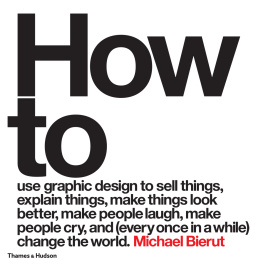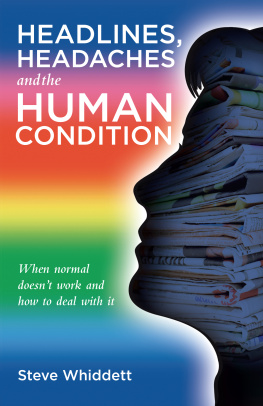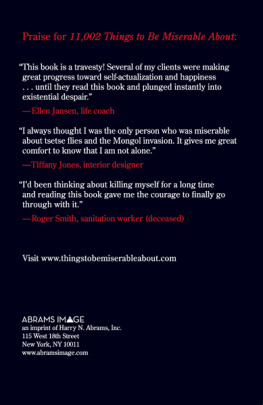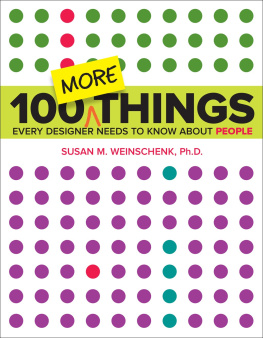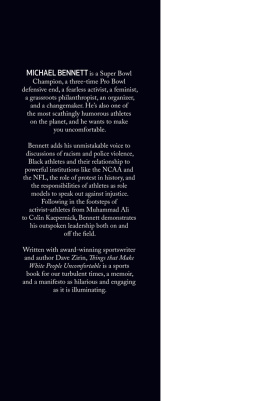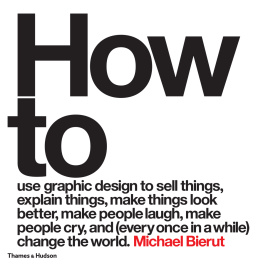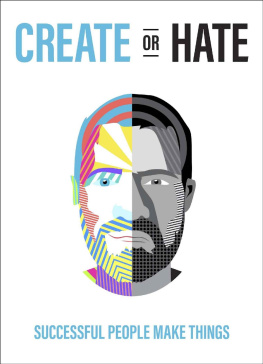Bierut - How to use graphic design to sell things, explain things, make things look better, make people laugh, make people cry, and (every once in a while) change the world
Here you can read online Bierut - How to use graphic design to sell things, explain things, make things look better, make people laugh, make people cry, and (every once in a while) change the world full text of the book (entire story) in english for free. Download pdf and epub, get meaning, cover and reviews about this ebook. City: London, year: 2015, publisher: Thames & Hudson, Ltd., genre: Home and family. Description of the work, (preface) as well as reviews are available. Best literature library LitArk.com created for fans of good reading and offers a wide selection of genres:
Romance novel
Science fiction
Adventure
Detective
Science
History
Home and family
Prose
Art
Politics
Computer
Non-fiction
Religion
Business
Children
Humor
Choose a favorite category and find really read worthwhile books. Enjoy immersion in the world of imagination, feel the emotions of the characters or learn something new for yourself, make an fascinating discovery.
- Book:How to use graphic design to sell things, explain things, make things look better, make people laugh, make people cry, and (every once in a while) change the world
- Author:
- Publisher:Thames & Hudson, Ltd.
- Genre:
- Year:2015
- City:London
- Rating:5 / 5
- Favourites:Add to favourites
- Your mark:
- 100
- 1
- 2
- 3
- 4
- 5
How to use graphic design to sell things, explain things, make things look better, make people laugh, make people cry, and (every once in a while) change the world: summary, description and annotation
We offer to read an annotation, description, summary or preface (depends on what the author of the book "How to use graphic design to sell things, explain things, make things look better, make people laugh, make people cry, and (every once in a while) change the world" wrote himself). If you haven't found the necessary information about the book — write in the comments, we will try to find it.
Bierut: author's other books
Who wrote How to use graphic design to sell things, explain things, make things look better, make people laugh, make people cry, and (every once in a while) change the world? Find out the surname, the name of the author of the book and a list of all author's works by series.
How to use graphic design to sell things, explain things, make things look better, make people laugh, make people cry, and (every once in a while) change the world — read online for free the complete book (whole text) full work
Below is the text of the book, divided by pages. System saving the place of the last page read, allows you to conveniently read the book "How to use graphic design to sell things, explain things, make things look better, make people laugh, make people cry, and (every once in a while) change the world" online for free, without having to search again every time where you left off. Put a bookmark, and you can go to the page where you finished reading at any time.
Font size:
Interval:
Bookmark:
How to 00882_Bierut_CS5.5_PENTAGRAM_02.indd 1 30/04/2015 14:0
How to use graphic design to sell things, explain things, make things look better, make people laugh, make people cry, and (every once in a while) change the world 00882_Bierut_CS5.5_PENTAGRAM_02.indd 2 30/04/2015 14:0
How to use graphic design to sell things, explain things, make things look better, make people laugh, make people cry, and (every once in a while) change the world 00882_Bierut_CS5.5_PENTAGRAM_02.indd 3 30/04/2015 14:0
First published in the United Kingdom in 2015 by Thames & Hudson Ltd, 181A High Holborn, London WC1V 7QX How to Michael Bierut 2015 Typeset in NeueHelvetica DOT Used by special arrangement with Monotype and the New York City Department of Transportation Written and designed by Michael Bierut Production management by Sonsoles Alvarez with Chloe Scheffe Production supervision by Julia Lindpaintner Design supervision by Hamish Smyth Editorial consulting by Andrea Monfried Copy editing by Rebecca McNamara All Rights Reserved. No part of this publication may be reproduced or transmitted in any form or by any means, electronic or mechanical, including photocopy, recording or any other information storage and retrieval system, without prior permission in writing from the publisher. British Library Cataloguing-in-Publication Data A catalogue record for this book is available from the British Library ISBN 978-0-500-51826-7 Manufactured in China by Imago To find out about all our publications, please visit www.thamesandhudson.com. There you can subscribe to our e-newsletter, browse or download our current catalogue, and buy any titles that are in print.00882_Bierut_CS5.5_PENTAGRAM_02.indd 4 01/06/2015 12:5
First published in the United Kingdom in 2015 asHow to ISBN 978-0-500-51826-7by Thames & Hudson Ltd, 181a High Holborn, London WC1V 7QXHow to Michael Bierut 2015 Typeset in NeueHelvetica DOTUsed by special arrangement with Monotype and the New York City Department of Transportation Written and designed by Michael Bierut Production management by Sonsoles Alvarez with Chloe Scheffe Production supervision by Julia Lindpaintner Design supervision by Hamish Smyth Editorial consulting by Andrea Monfried Copy editing by Rebecca McNamara This electronic version first published in 2015 byThames & Hudson Ltd, 181a High Holborn, London WC1V 7QX To find out about all our publications, please visitwww.thamesandhudson.com All Rights Reserved. No part of this publication may be reproducedor transmitted in any form or by any means, electronic or mechanical, including photocopy, recording or any other information storage and retrieval system, without prior permission in writing from the publisher. ISBN 978-0-500-77307-9
Contents 10 How to be a graphic designer in the middle of nowhere An introduction 16 How to think with your hands Four decades of notebooks 36 How to destroy the world with graphic design American Institute of Graphic Arts 40 How to have an idea The International Design Center, New York 42 How to transcend style American Center for Design 44 How to create identity without a logo Brooklyn Academy of Music 52 How to invent a town that was always there Celebration, Florida 60 How to work for free Parallax Theater 66 How to raise a billion dollars Princeton University 70 How to win a close game New York Jets 00882_Bierut_CS5.5_PENTAGRAM_02.indd 5 30/04/2015 14:0
80 How to be good The Good Diner 86 How to run a marathon The Architectural League of New York 100 How to avoid the obvious Minnesota Childrens Museum 106 How to avoid doomsday Bulletin of the Atomic Scientists 1 1 2 How to be fashionably timeless Saks Fifth Avenue 124 How to cross cultures New York University Abu Dhabi 130 How to behave in church The Cathedral Church of St. John the Divine 138 How to disorient an architect Yale University School of Architecture 154 How to put a big sign on a glass building without blocking the view The New York Times Building 164 How to make a museum mad Museum of Arts and Design 172 How to judge a book Covers and jackets 178 How to make a mark Logotypes and symbols 190 How to squash a vote The Voting Booth Project 192 How to travel through time Lever House 196 How to pack for a long flight United Airlines 204 How to have fun with a brown cardboard box Nuts.com 21 0 How to shut up and listen New World Symphony 00882_Bierut_CS5.5_PENTAGRAM_02.indd 6 30/04/2015 14:0
282 How to survive on an island Governors Island 292 How to design two dozen logos at once MIT Media Lab 306 How to save the world with graphic design The Robin Hood Foundations Library Initiative 318 Acknowledgments 320 Image credits 216 How to top the charts Billboard 224 How to convince people Ted 234 How to get where you want to be New York City Department of Transportation 246 How to investigate a murder A Wilderness of Error 252 How to be who you are Mohawk Fine Papers 258 How to get the passion back American Institute of Architects 266 How to make news Charlie Rose 274 How to set a table The restaurants of Bobby Flay 00882_Bierut_CS5.5_PENTAGRAM_02.indd 7 30/04/2015 14:0
00882_Bierut_CS5.5_PENTAGRAM_02.indd 8 30/04/2015 14:0
Inspiration is for amateurs. The rest of us just show up and get to work. Chuck Close 00882_Bierut_CS5.5_PENTAGRAM_02.indd 9 30/04/2015 14:0
00882_Bierut_CS5.5_PENTAGRAM_02.indd 10 30/04/2015 14:0
How to be a graphic designer in the middle of nowhere An introduction Opposite My first mass-produced piece of graphic design was a poster for our high school production of Wait Until Dark, a tense drama about a blind woman threatened by a criminal gang (hence the eyes). I can still remember the thrill of seeing it hanging in every hallway of my high school.00882_Bierut_CS5.5_PENTAGRAM_02.indd 11 As far back as I can remember, I always wanted to be a graphic designer.I must have been no more than five or six years old. I was in the car with my father on a Saturday on my way to get a haircut. We were stopped at a light, and my dad pointed at a forklift truck parked in a nearby lot. Isnt that neat? he asked. What, I said. Look at the way they wrote Clark. Clark was the logo on the side of the truck. I didnt get it. See how the letter L is lifting up the letter A? explained my father. Its doing what the truck does. It was as if an amazing secret had been revealed, right there in plain sight. I was dumbfounded and thrilled. How long had this been going on? Were these small miracles hidden all over the place? And who was responsible for creating them?I was in the first grade at St. Theresas School in Garfield Heights, Ohio, when my teachers first noticed that I was good at drawing. This was no small thing. I was a good student, but among my peers in 1960s suburban Cleveland, academic diligence was viewed with suspicion, if not outright contempt. Artistic ability, on the other hand, was like a kind of magic. Inept at sports and generally withdrawn, I suddenly had a way to distinguish myself in the schoolyard. The nuns called it a God-given talent, and I milked it for all it was worth. Luckily, I received nothing but encouragement from my parents. They bought me a succession of ever-more esoteric implements (charcoal sticks! pastels! kneaded erasers!) and signed me up for Saturday morning art classes at one of the worlds great cultural institutions, the Cleveland Museum of Art. By the time I reached junior high school, I could render anything realistically. Everyone assumed I would be an artist when I grew up. Art was something I used to make friends (and, occa- sionally, to keep from getting beaten up). At the request of one of the schools more frightening bullies, I painstakingly replicated the Budweiser logo on the cover of his civics notebook. Having acquired a Speedball pen set and having mastered a convincing Fraktur, I generated heavy metal insignia upon request. 11 30/04/2015 14:0
A turning point came in the ninth grade when I was asked to do a poster for the school play. I handed in the artwork on a Friday morning, it was printed that afternoon, and by Monday morning my poster was hanging all over the school. This was my first experience with the miracle of mass production. More people would see my poster than would see the play. I realized then I didnt want to settle for just doing a single painting to be stuck on the wall at someplace like the Cleveland Museum of Art. I wanted to create things with a purpose, things that people would see all over the place, things that were about something other than themselves. It was hard to explain.I had no idea how posters and logos came into the world. I didnt know any working artists, and didnt know anyone else to ask. If pressed, I would have guessed that things like album covers were designed by real artists like Franz Kline and Robert Rauschenberg who had decided to take a day off and make some extra money. One day, I was in our school library, idly browsing the Career Resource Center. This was a grandiose name for what was no more than a shelf bearing a matched set of books called the Aim High Vocational Series. The titles included Aim for a Job in Baking, Aim for a Job in the Dry Cleaning Industry, and Aim for a Job in Domestic Help Occupations. One caught my eye: Aim for a Job in Graphic Design/Art by someone named S. Neil Fujita. I opened it and realized with a start that I was staring at my future.Here were page after page of men and women who were doing what I wanted to do, with examples of work from ad man George Lois, magazine designer Ruth Ansel, and television art director Lou Dorfsman. I now realized this activity that fascinated me had a name: graphic design. Newly armed and wanting more, I went to my local public library and looked up those two words in the card catalog. There was exactly one book listed. It was Graphic Design Manual: Principles and Practice by Armin Hofmann. An introduction Above Easter Sunday, 1969, in Parma, Ohio. Im standing with my parents, Leonard and Anne Marie, and behind my twin brothers, Ronald and Donald.Above My parents enrolled me in Saturday morning art classes at the Cleveland Museum of Art. Here is my rendition of a masterpiece in their collection, J. M. W. Turners The Burning of the Houses of Lords and Commons. I was seven years old.12 00882_Bierut_CS5.5_PENTAGRAM_02.indd 12 30/04/2015 14:0
Next pageFont size:
Interval:
Bookmark:
Similar books «How to use graphic design to sell things, explain things, make things look better, make people laugh, make people cry, and (every once in a while) change the world»
Look at similar books to How to use graphic design to sell things, explain things, make things look better, make people laugh, make people cry, and (every once in a while) change the world. We have selected literature similar in name and meaning in the hope of providing readers with more options to find new, interesting, not yet read works.
Discussion, reviews of the book How to use graphic design to sell things, explain things, make things look better, make people laugh, make people cry, and (every once in a while) change the world and just readers' own opinions. Leave your comments, write what you think about the work, its meaning or the main characters. Specify what exactly you liked and what you didn't like, and why you think so.

